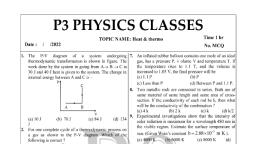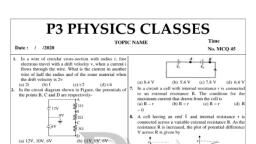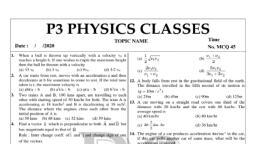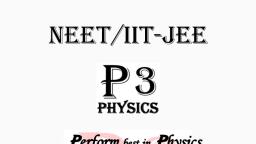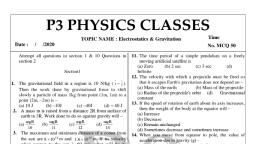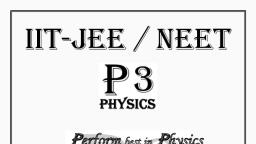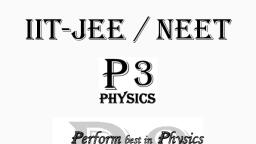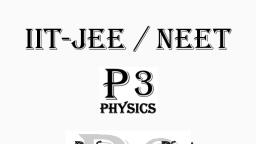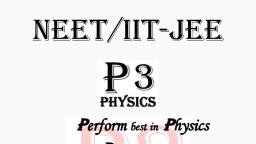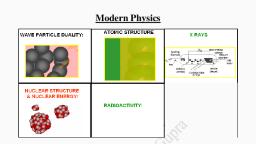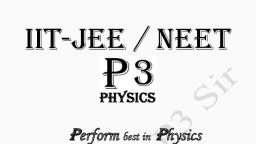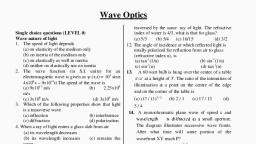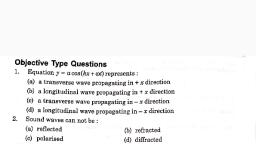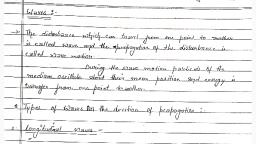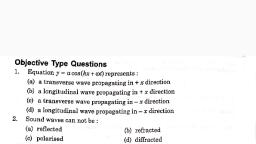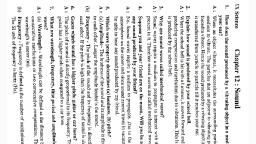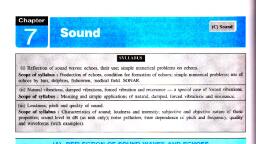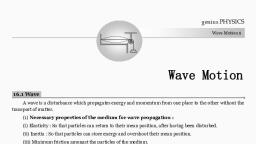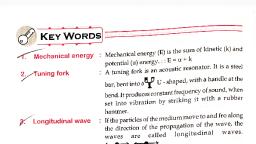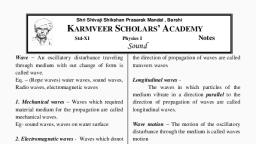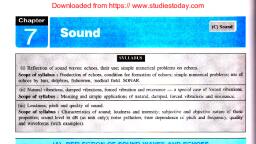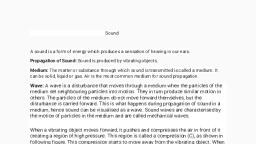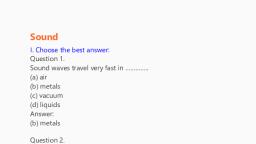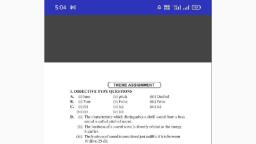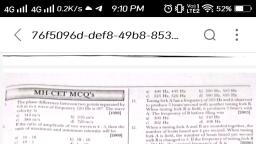Page 2 :
Wave & Sound, , Wave Equation: Transverse wave in string, Wave Equation, , (a) 1 m/s (b) 0.5 m/s, (c) 2 m/s, (d) 4 m/s, 3. Which of the following functions of x and t represents, a progressive wave, 1, (a) y = sin (4t 3x), (b) y =, 4 (4t 3x ) 2, 1, (c) y =, (d) a & b both, 4t 3x, 4. The transverse displacement y(x,t) of a wave on a, string is given by, , y( x, t ) e ax, , 2 bt 2 2, , abxt, , . This, , represents a, (a) wave moving in –x direction with speed, (b) standing wave of frequency, , b, a, , b, , (c) standing wave of frequency 1, b, , 1. A transverse wave is passing through a medium. The, maximum speed of the vibrating particle occurs, when the displacement of the particle from the mean, position is:, (a) zero, (b) half of the amplitude, (c) equal to the amplitude (d) none of the above., 2. The amplitude of wave disturbance propagating in, 1, positive x-axis is given by y=, at t = 0 and y =, 1 x², , 1, at t = 2s, where x and y are in metres., 1 ( x 1) 2, The shape of the disturbance does not change during, the propagation. The velocity of the wave is, , (d) wave moving in +x direction with, , a, b, , 5. Equation of a progressive wave is given by, y=0.2cos⊼ {0.04t +.02x-⊼/6}, The distance is expressed in cm and time in, secondwhat will be the minimum distance between, two particles having the phase difference of /2, (a)4cm (b)8cm, (c)25cm, (d)12.5cm, 6. The equation of a wave travelling on a string is v=4sin, /2 {8t-x/8}if x and y are in cm, then velocity of, wave is, (a) 64cm/sec in –x direction, (b) 32cm/ sec in –x direction, (c) 32cm/ sec in +x direction
Page 3 :
(d) 64cm/sec in +x direction, 7. The angle between particle velocity and wave, velocity in a transverse wave is :, (a) zero, (b) /4, (c) /2, (d) , 8. Surfaces waves strike with their crests 160 m apart., The velocity of the waves is 40 ms-1. The time, interval between two crests striking the rock is, (a) 1s, (b) 2 s, (c) 4 s, (d) 8s., 9. Two waves are given by y1 a sin(t kx) and, , y 2 a cos(t kx) The phase difference between, , the two waves is, (a), , , 4, , (b) π, , (c), , , 8, , (d), , , 2, , 10. Wave equations of two particles are given by, y1=a sin (wt-kx) ,y2 =a sin (kx+wt), then, (a)they are moving in opposite direction, (b)phase between then is 900, (c)phase between them is1800, (d)phase between them is00, 11. A transverse wave is described by the equation Y=, , x, , Y0 sin 2 ft . The maximum particle velocity, , , is four times the wave velocity if, (a) , , Y0, 4, , (b) , , Y0, 2, , (c) Y0 (d) 2Y0, , 12. The displacement y of a wave travelling in the x-, , , , , direction is given by y =10-4 sin 600t 2 x , , , , 3, , metres, where x is expressed in meters and t in, seconds. The speed of the wave-motion, in ms-1, is, (a) 300, (b) 600, (c) 1200, (d) 200, 13. A wave travelling along the x-axis is described by the, equation y(x,t) = 0 .005 cos (α x – βt). If the, wavelength and the time period of the wave are, 0.08m and 2.0s, respectively, then α and β in, appropriate units are, (a) α = 25.00 π , β = π, (c) α =, , 0.04, , , , , , , 1.0, , , , (b) α =, , 0.08, , , , , , , (d) α = 12.50 π, β =, , 2.0, , , , 2 .0, , 14. The displacement y of a particle in a medium can, be expressed as, y = 106sin(100t + 20 x + /4) m,, where t is in seconds and x in meter. The speed of, the wave is, (a) 20 m/s (b) 5 m/s (c) 2000 m/s (d) 5 m/s., 15. The displacement y of a particle in a medium can be, expressed as; y = 10-6 sin(100t+ 20x + π/4)m, where t, is in second and x in meter. The speed of wave is, (a) 2000 m/s (b) 5 m/s (c) 20 m/s (d) 5π m/s, 16. A sine wave is traveling in a medium. A particular, particle has zero displacement at a certain instant., The particle closed to it having zero displacement is, at a distance, , , , (a), (b), (c), (d) , 4, 3, 2, , 17. Which of the following equations represents a wave, traveling along Y-axis?, (a) x = A sin (kyt), (b) y = A sin (kxt), (c) y = A sin kx cos t, (d) y = A cos ky sin t, 18. The diagram below shows, C, , the propagation of wave., A, , B, , Which points are in phase?, (a) A. B, , (b) B, C, , D, , (c) B, D, , E, , (d) E, B, , 19. Which of the following is not the standard form of a, sine wave?, t x, (a) y = A sin2 , (b) y = A sin(vtkx), T , x, (c) y = A sin t , (d) y = A sin(ωtkx), v, , 20. The equation of transverse wave is given by y = 10, sin (0.01x-2t) where y and x are in cm and t in sec., Its frequency is, (a) 10 Hz (b) 2 Hz, (c) 1 Hz (d) 0.01 Hz, 21. A traveling wave in a stretched string is described, by the equation y = A sin (kx –ωt) The maximum, particle velocity is, (a) A ω, (b) ω / k, (c) dω / dx, (d) x / t, 22. A transverse sinusoidal y, wave moves along a, string in the positive xdirection at a speed of, 10 cm/s. The, P, wavelength of the wave, x, is 0.5 m and its, amplitude is 10 cm. At, a particular time t, the, snap-shot of the wave is shown in figure. The, velocity of point P when its displacement is 5 cm is-, , 3, ĵ m / s, 50, 3 ˆ, (c), i m/s, 50, , 3, ĵ m / s, 50, 3 ˆ, (d) im/s, 50, , (a), , (b) -, , 23.In a transverse wave the distance between a crest and, through at the same place is 1.0 cm. The next crest, appears at the same place after a time interval of 0.4s., The maximum speed of the vibrating particles in the, medium is:, (a) 3, (b) 5, 2, , cm / s, , (c) cm / s, , 2, , cm / s, , (d) 2 cm / s, , 2, , 24. A transverse wave is represented by:, y, , 2, 2, sin , t, , , T, , 10, , , x, , , For what value of the wavelength the wave velocity is, twice the maximum particle velocity?, (a) 40cm (b) 20cm, , (c) 10cm, , (d) 60cm
Page 4 :
25. A transverse sine wave of amplitudes 10 cm and, wavelength 200 cm travels from left to right along a, long horizontal stretched string with a speed of 100, cm/s. Take the origin at left end of the string. At time, t = 0 the left end of the string is at the origin and is, moving downward. Then the equation of the wave, will be (in CGS system), (a)y = 10sin(0.01xt) (b) y = 10 sin(t 0.01x), (c) y = 10 sin(200x 0.01t), (d) y = 10 sin(t 0.02x), , 30, Hertz, , (iii) Of wavelength metes, (ii) Of frequency, , (iv) Moving in the positive x direction, Pick out the correct statements from the above, [AMU – 2011], (a) 1, 2, 4, , (b) 3, 4, , (c) 1, 2, 3, , (d) all, , 26. Two wave are represented by the equations, 30. The equation of a simple harmonic wave is given by:, , y1 a sin( t kx 0.57) m and, y2 a cos( t kx) m , where x is in meter and t in, sec. The phase difference between them is [AIPMT, 2011], (a) 1.25 radian, , (b) 1.57 radian, , (c) 0.57 radian, , (d) 1.0 radian, , y 3sin, , axis with speed 100 ms-1., , 2, , (50 t x) , where x and y are in metres, , and t is in seconds. The ratio of maximum particle, velocity to the wave velocity is [AIPMT Mains, 2012], (a) 3, , 27. A travelling wave is represented by the equation y (x,, t) = 10-3 sin (50t + 2x), where x and y are in meter, and t is in seconds. Which of the following is a, correct statement about the wave? [JEE Mains2019], The wave is propagating along the, (a) Negative x-axis with speed 25 ms-1., (b) The wave is propagating along the positive xaxis with speed 25 ms-1., (c) The wave is propagating along the positive x-, , , , (b), , 2, , 3, , (c) 2, , (d), , 3, , 2, , 31. A wave travelling in the +ve x-direction having, displacement along y-direction as 1m. wavelength, 2 m and frequency of, , 1, , , , Hz is represented by:, , [NEET 2013], (a) y sin(2 x 2 t) (b) y sin(10 x 20 t), (c) y sin(2 x 2 t) (d) y sin(x 2 t), , Energy,Power,Intensity,speed of transverse wave, , (d) The wave is propagating along the negative xaxis with speed 100 ms-1., 28. A progressive wave travelling along the positive xdirection is represented by y(x, t) =, A sin(kx t ) . Its snapshot at t = 0 is given in, the figure., [JEE Mains-2019], , Fir this wave, the phase ø is:, (a) 0, , (b) , , , 2, , (c) , , (d), , , 2, , 29. A travelling wave is represented by the equation, , y, , 1, sin(60 t 2 x) , where x and y are in metres, 10, , and t is in seconds. This represents a wave., (i) Travelling with a velocity of 30 m/s., , 32. The relation between time and displacement for two, particles is given by y1=0.06 sin, 2 (0.04t+ 1)y2=0.03sin2 (.04+ 2), The ratio of the intensity of the waves produced by, the vibrations of the particles will be, (a)2:1, (b)1:2, (c)4:1, (d)1:4, 33. A string of length L is stretched by L/20 and speed of, transverse wave along it is v. The speed of wave, when it is stretched by L/10 will be (assume that, Hooke’s law is applicable)
Page 5 :
(a) 2 v, , (b), , v, , (c) 2 v, , (d) 4 v, , 2, 34. A metal string is fixed between rigid supports. It is, initially at negligible tension. Its Young’s modulus is, Y, density is and coefficient of thermal expansion, is . If it is now cooled through a temperature = t,, transverse waves will move along it with speed, t, Y, Yt, Y, (a) Y, (b) t, (c), (d) t, , , , , 35. A heavy rope is suspended from a rigid support. A, wave pulse is setup at the lower end, then, (a) the pulse will travel with uniform speed, (b)the pulse will travel with increasing speed, (c)the pulse will travel with decreasing speed, (d)the pulse cannot travel through the rope, 36. The equation of a wave on a string of linear mass, density 0.04 kg m-1 is given by, , t, ., x, y 0.02(m)sin 2 , , , 0.04(, s, ), 0.50(, m, ), , , , the string is, (a) 4.0N (b) 12.5N (c) 0.5N, , The tension in, , (d) 6.25N, , 37. Two strings A and B of same material are stretched, by same tension. The radius of string A is double of, the radius of B. A transverse wave travels in A with, speed vA and in B with speed vB. The ratio vA/vB is, (a) ½, (b) 2, (c) ¼, (d) 4, 38. A uniform string of length 20m is suspended from a, rigid support. A short wave pulse is introduced at its, lowest end. It starts moving up the string. The time, taken to reach the support is: (take g = 10ms-2), [JEE MAIN 2016], (a) 2s (b) 2 2s (c) 2s, (d) 2 2s, , Principle of superposition, , 1., Two wave pulses travel in opposite directions in, a string and approach each other. The shape of one pulse, in inverted with respect to the other., (a) the pulses will collide with each other and vanish, after collision, (b) the pulses will be reflected from each other i.e., the pulse going towards right will finally move, towards left and vice versa, (c) the pulses will pass through each other but their, shapes will be modified, (d) the pulses will pass through each other without, any change in their shapes., Superposition of SHM, 2. The displacement of two identical particles executing, SHM are represented by equations, , , , x1 = 4 sin 10t and x2 = 5 cos t, 6, , For what value of energy of both the particles is, same., (a) 16 units (b) 6 units (c) 4 units (d) 8 units, 3. Two waves having equation x1=a sin ( t +δ1) , x2=a, sin ( t +δ2) If in the resultant wave the frequency, and amplitude remain remain equal to those of, superimposing waves. then phase difference between, them is, (a) /6, (b)2 /3, (c) /4, (d) /3, 4.The motion of a particle is given by x = A sint + B, cost. The motion of the particle is, (a) not simple harmonic, (b) simple harmonic with amplitude A + B, (c) simple harmonic with amplitude (A + B)/2
Page 6 :
(d) simple harmonic with amplitude A² B², 5. Four simple pendulum vibrations x1 = 8 sint, x2 = 6, sin (t+/2), x3 = 4 sin (t+) and x4 = 2 sin (t +, 3/2) are superimposed on each other. The resulting, amplitude and its phase difference with x1 are, respectively., , (a) 20, tan1(½ ), (b) 4 2 ,, 2, , 1, (c) 20,tan (2), (d) 4 2 ,, 4, 6. Equation of motion in the same direction is given by, y1=A sin ( t-kx) y2=A sin ( t-kx+ θ). the amplitude, of the medium particle will be, (a)2A cos θ/2, (b)2A cos θ, (c) A cos θ/2, (d)1.2f , 1.2, Interference in string., , 11. In an interference experiment the ratio of amplitudes, of coherent waves is, , a1 1, . The ratio of, a2 3, , maximum and minimum intensities of fringes will, be:, [JEE Mains-2019], (a) 4, (b) 2, (c) 9, (d) 18, Reflection refraction Stationary waves concept, 12. A wave is reflected from a rigid support. The change, in phase on reflection will be:, (a) /4, (b) /2, (c) , (d) 2., 13. A wave pulse is travelling along a, light taut string which ends in a Incoming pulse, frictionless ring which is free to, move in a transverse direction., After reflection, the string might, show the wave pulse (see figure), (a), , (b), , (c), , (d) none, , 14. A wave pulse on a string has the dimension shown in, the figure. The, v = 1 cm/s, wave speed is, 1 cm, O, v = 1 cm/s. If, point O is a, 2 cm, 1 cm 1 cm, free end. The, shape of wave at time t = 3 s is, O, , (a), , 1 cm, , O, , (b), 1 cm, , 7. Two waves of same frequency and intensity, superimpose with each other in opposite phases then, after superposition the, (a)intensity increases by 4 times, (b)intensity increases by two times, (c)frequency increase by 4 times, (d)none of these, 8.Two waves having the intensities in the ratio of 9:1, produce interference. The ratio of maximum to, minimum intensity is equal to, (a) 10:8, (b) 9:1, (c) 4:1, (d) 2:1., 9. Two waves of intensities I and 4I superimpose. The, minimum and maximum intensities will respectively, be :, (a) 3I, 5I (b) I, 5I (c) I, 9I (d) none of the above., 10. Two coherent sources produces waves of different, intensities which interfere. After interference, the, ratio of the maximum intensity to the minimum, intensity is 16. The intensity of the waves are in the, ratio:, [JEE Mains-2019], (a) 4 : 1, (b) 25 : 9, (c) 16 : 9, , (d) 5 : 3, , O, , 1 cm, , (c), , 1 cm, , 2 cm, , (d), , O, , 1 cm, , 15. In the above problem, shape of the wave at time t = 3, O, s if O is a fixed end will be, 1 cm, , O, , (a), , (b), , 1 cm, , O, , 1 cm, , 2 cm, 1 cm, , (c), , (d), , O, 1 cm, , 16. In stationary waves all particles between two nodes, pass through the mean position, (a)At different times with different velocities, (b) At different times with the same velocity, (c) At the same time with equal velocity, (d) At the same time with different velocities
Page 7 :
17. Length of a string tied to two rigid supports is 40 cm., Maximum length (wavelength in cm) of a stationary, wave produced on it is, (a) 20, (b) 80, (c) 40, (d) 120., 18. Two identical wave trains travelling in opposite, directions present simultaneously in a medium, produce stationary waves. E is the energy crossing, any point of the medium when one wave is present in, the medium. The energy crossing any point of the, medium when stationary waves are produced is:, (a) E, (b) 2E, (c) E/2, (d) zero., 19. The amplitude of vibration of any particle in a, standing wave, produced along a stretched string, depends on :, (a) frequency of incident wave, (c) location of particles, (b) time period of reflected wave, (d) time., 20. A standing wave is produced on a string clamped at, one end and free at the other. The length of the string, (a) must be an integer multiple of /4, (b) must be an integer multiple of , (c) must be an integer multiple of /2, (d) may be an integer multiple of /2., Natural frequencies of Stationary waves in string, , (a) 6:3:2 (b) 4:3:2, (c) 4:2:1, (d) 3:2:1., 23.Of the following, which type of vibrations are, produced in wire of a guitar?, (a) progressive transversal vibration, (b) stationary longitudinal vibration, (c) progressive longitudinal vibration, (d) stationary transversal vibration, 24. A string of length 1 m and mass 5g is fixed at both, ends. The tension in the string is 8.0N. The string is, set into vibration using an external vibrator of, frequency 100 Hz. The separation between, successive nodes on the string is close to: [JEE, Mains-2019], (a) 16.6 cm, (b) 20.0 cm, (c) 10.0 cm, (d) 33.3 cm, 25. A wire of length 2L, is made by joining two wires A, and B of same length but different radii r and 2r and, made of the same material. It is vibrating at a, frequency such that the joint of the two wires forms a, node. If the number of antinodes in wire A is p and, that in B is q then the ratio p : q is: [JEE Mains2019], , (a) 4 : 9, , (b) 3 : 5, , (c) 1 : 4, , (d) 1 : 2, , 26., , A string 2.0 m long and fixed at its ends is driven, by a 240 Hz vibrator. The spring vibrates in its third, harmonic mode. The speed of the wave and its, fundamental frequency is [JEE Mains-2019], (a) 320 m/s, 120 Hz, (b) 180 m/s, 80 Hz, (c) 180 m/s, 120 Hz, (d) 320 m/s, 80 Hz, 27. A string is clamped at both the ends and it is, vibrating in its 4th harmonic. The equation of the, stationary wave is Y = 3.0 sin(0.157x) cos( 200 t )., The length of the string is: (All quantities are in SI, units)., [JEE Mains-2019], (a) 20m (b) 80m, (c) 60 m, (d) 40 m, 28. If n1, n2 and n3 are the fundamental frequencies of, three segment into which a string is divided. Then the, original fundamental frequency n of the string is, given by, [AIPMT 2012, 14], (a), 21. A tuning fork of frequency 480 Hz is used to vibrate, a sonometer wire having natural frequency 410 Hz., The wire will vibrate with a frequency:, (a) 410 Hz (b) 480 Hz, (c) 820 Hz (d) 960 Hz., 22. A sonometer wire is to be divided into three, segments having fundamental frequencies in the ratio, 1:2:3. What should be the ratio of lengths?, , n n1 n2 n3, , (b) n n1 n2 n3, , 1 1 1 1, , n, n1 n2 n3, (c), 1, 1, 1, 1, (d), , , , n, n1, n2, n3
Page 8 :
Longitudinal wave: sound wave, , Wave equation. Speed of Sound, 1. When two sound waves travel in the same direction in, a medium the displacements of a particle located at, ‘x’ at the time ‘t’ is given by, [JEE MAIN, 2013], y1 0.05cos(0.50 x 100 t ), y2 0.05cos(0.46 x 92 t ), Where y1, y2 and x are the metres and t in seconds., The speed of sound in the medium is, (a) 92m/s (b) 200m/s (c) 100 m/s (d) 332 m/s, 2. A sound wave of frequency 500 hz covers a distance, of 1000 metres in 5 seconds between points X and Y., Then the number of waves between X and Y., (a) 500, (b) 1000 (c) 2500, (d) 5000., 3. Sound waves in air cannot be polarized because:, (a) their speed is small (b) these are longitudinal, (c) they require medium (d) their speed is, temperature dependent., 4. Equation y(x,t) = A cos (kx – t) represents,, (a) transverse wave travelling along + X direction, (b) transverse wave travelling along X direction, (c) longitudinal wave travelling along + X direction, (d) longitudinal wave travelling along X direction., 5. A 10 watt source of sound of frequency 1000 Hz, sends out waves in air. The displacement amplitude, at a distance of 10 m from the source is (speed of, sound in air = 340 m/s and density of air = 1.29, kg/m3), (a) 0.62 µm (b) 4.2 µm (c) 1.6 µm (d) 0.96 µm
Page 9 :
6. A sound wave is represented by y = a sin (1000t , 3x). The distance between two points having a phase, difference of /3 is, (a) 2/9, (b) /18, (c) /9, (d) 5/18, 7. Two sound waves move in the same direction. If the, average power transmitted across a cross section by, them are equal while their wavelengths are in the, ratio of 1:2. Their pressure amplitudes would be in, the ratio of, (a) 1, (b) 2, (c) 4, (d) 1/2, 8. The isothermal elasticity of the medium is FT and the, adiabatic elasticity is ES. The velocity of the sound, the medium is proportional to:, (a) ET, (b) ES, (c)ET, (d) ES., 9. Under similar conditions of temperature and, pressure, velocity of sound will be largest in the gas:, (a) H2, (b) N2, (c) O2, (d) CO2., 10. When a sound wave of frequency 300 Hz passes, through a medium, the maximum displacement of a, particle of the medium is 0.1 cm. The maximum, velocity of the particle is equal to:, (a) 60 cm/sec, (b) 30 cm/sec, (c) 30 cm/sec, (d) 60 cm/sec., 11. The temperature at which the speed of sound in air, becomes double of its value at 27°C is, (a) 54°C (b) 327° (c) 927°C, (d) –1230°C, 12. Velocity of sound in a gas is proportional to:, (a) square root of adiabatic elasticity, (b) square root of isothermal elasticity, (c) adiabatic elasticity, (d) isothermal elasticity., 13. The rms velocity of the molecules of a gas is c and, the velocity of sound in this gas is v. The relation, between v and c is, (a) (v/c) = /3, (b) (v/c) = 3, (c) (v/c) = (3), (d) (v/c) = (/3)., 14. The velocities of sound in an ideal gas at temperature, T1 and T2 K are found to be V1 and V2 respectively., If the root mean square speed of the same gas at the, same temperatures T1 and T2 are v1 and v2, respectively, then:, (a) v2 = v1 (V2/V1), (b) v2 = v1 (V1/V1), (c) v2 = v1 (V2/V1), (d) v2 = v1 (V1/V2)., 15. Velocity of sound in oxygen at NTP in v. The, velocity of sound in helium at NTP should be:, (a) 4v (b) 22v, (c) 2v, (d) none of these, 16. A sound wave of frequency 256 Hz travels at 330, m/s through the air. At what speed does a sound, wave of frequency 512 Hz travels through the same, air, (a) 165 m/s (b) 330 m/s (c) 660 m/s (d) 1320 m/s., 17. Two monoatomic ideal gases 1 and 2 of molecular, masses m1 and m2 respectively are enclosed in, separate containers kept at the same temperature. The, ratio of the speed of sound is gas 1 to that in gas 2 is, given by, (a) √(m1 / m2 ) (b) √(m2 / m1 ) (c) m1 / m2 (d) m2 / m1, 18.The speed of sound in oxygen (O2) at a certain, temperature is 460 ms-1. The speed of sound in, , helium (He) at the same temperature will be, (assumed both gases to be is, (a) 460 ms-1 (b) 500 ms-1 (c) 650 ms-1 (d), 1420 ms-1, 19. An increase in pressure of 100 kPa causes a certain, volume of water to decrease by 5 x 10-3 per cent of, its original volume. The speed of sound, (compressional waves) in water is close to: [AMU, 2012], (a) 1000 m/s, , (b) 1200 m/s, , (c) 1400 m/s, , (d) 1700 m/s, , 20. An astronaut can’t hear his companion at the surface, of the moon because:, (a) produced frequencies are above the audio, frequencies, (b) there is no medium for sound propagation, (c) temperature is too low during night and too high, during day, (d) there are too many craters on the surface of the, moon., Echo ,Pitch, quality and loudness of a sound:, , 21. A man stands between two parallel cliffs (not in, middle). When he claps his hands, he hears two, echoes one after 1 second and the other after 2, seconds. If the velocity of sound in air is 330 ms-1,, the width of the valley is:, (a) 330 m (b) 495 m (c) 660 m (d) 990 m, 22. The power of sound from the speaker of a radio is 20, mW. By tuning the knob of volume control the, power of sound is increased to 400 mW. The, intensity level increases by:, (a) 1.3 dB, (b) 3.1 dB, (c) 13 dB, (d) 30.1 dB, 23. A point source emits sound equally in all directions, in a non-absorbing medium. Two points P and Q are, at distances of 2m and 3m respectively from the, source. The ratio of the intensities of the waves at P, and Q is:, (a) 9 : 4, (b) 2 : 3, (c) 3 : 2, (d) 4 : 9, 24. The intensity level of sound A is 2 bel greater than of, B. How many times more intense is the sound A than, B?
Page 10 :
(a) 10, (b) 100 (c) 1000, (d) 2, 25. A twofold increase in the intensity of a wave implies, an increase of:, (a) 2 dB, (b) 10 dB, (c) 3.01 dB, (d) 0.5 dB, 26. A small speaker delivers 2W of audio output. At, what distance from the speaker will one detect 120, dB intensity sound? [Given reference intensity of, sound as 10-12 W/m2], [JEE Mains-2019], (a) 10 cm, (b) 30 cm, (c) 40 cm, (d) 20 cm, 27. Compressional wave impulses are sent to the bottom, of sea from a ship and the echo is heard after 2, seconds. If bulk modulus of water is 2x109, newton/metre² and the mean temperature is 4°C, then, the depth of send is, (a) 707 metres, (b) 1404 metres, (c) 2828 metres, (d) 2000x103 metres., 28. Voice of a child is more shrill than that of an elderly, person because:, (a) the pitch of the child’s voice is higher than that of, the person, (b) the pitch is lower (c) the child is more energetic, (d) none of the above., 29. The minimum intensity of audibility of sound is 10-12, watt per metre². The intensity of a sound is 10-9 watt, per metre². The intensity level of this sound in, decibels is, (a) 1000, (b) 100, (c) 30, (d) 3., 30. The pitch of a musical note depends upon:, (a) Amplitude, (b) frequency, (c) wavelength, (d) velocity., 31. A sound absorber attenuates the sound level by 20db., The intensity decreases by a factor of, (a) 100, (b) 1000, (c) 10000, (d) 10, 32. When a source of sound approaches a stationary, observer the intensity of the sound wave, (a) is increased (b) is decreased(c)remains constant, (b) may increase or decrease depending on the speed, of source, 33. A source emits sound of frequency 600 Hz inside, water. The frequency heard in air will be equal to, (velocity of sound in water = 1500 m/s, velocity of, sound in air = 300 m/s), (a) 3000 Hz (b) 120 Hz (c) 600 Hz (d) 6000 Hz, Standing wave in resonance tube, , Can be done with string concept, 34. The fundamental frequency in an open organ pipe, is equal to the third harmonic of a closed organ pipe., If the length of the closed organ pipe is 20 cm, the, length of the open organ pipe is:- [NEET-2018], (a) 13.2 cm, (b) 8 cm, (c) 12.5 cm, (d) 16 cm, 35. A tube, closed at one end and containing air,, produces, when excited, the fundamental note of, frequency 512 Hz. If the tube is open at both ends the, fundamental frequency that can be excited is (in Hz), (a) 1024, (b) 512, (c) 256, (d) 128, 36. A pipe open at both ends has a fundamental, frequency f in air. The pipe is dipped vertically in, water so that half of it is in water. The fundamental, frequency of the air column is now:, [JEE, MAIN 2016], (a) 3 f, (b) 2f, (c) f, (d) f, 4, , 2, , 37. A pipe of length 85 cm is closed from one end. Find, the number of possible natural oscillations of air, column in the pipe whose frequencies lie below 1250, Hz. The velocity of sound in air is 340 m/s., (a) 6, (b) 4, (c) 12, (d) 8, 38. The number of possible natural oscillations of air, column in a pipe closed at one end of length 85 cm, whose frequencies lie below 1250 Hz are [AIPMT, 2014], (velocity of sound -340 ms-1), (a) 7, (b) 6, (c) 4, (d) 5, 39. The fundamental frequency of a closed organ pipe, of length 20 cm is equal to the second overtone of an, organ pipe open at both the ends. The length of organ, pipe open at both the ends is: [AIPMT 2015], (a) 100 cm, (b) 120 cm, (c) 140 cm, (d) 80 cm, 40. Tube A has both ends open while tube B has one end, closed, otherwise they are identical. The ratio of, fundamental frequency of tube A and B is, (a) 1 : 2, (b) 1 : 4, (c) 2 : 1, (d) 4 : 1, 41. A string is stretched between fixed points separated, by 75.0 cm. It is observed to have resonant, frequencies of 420 Hz and 315 Hz. There are no, other resonant frequencies between these two. Then,, the lowest resonant frequency for this string is, (a) 105 Hz (b) 1.05 Hz (c) 1050 Hz (d) 10.5 Hz, An air column, closed at one end and open at the, other. Resonates with a tuning fork when the smallest, length of the column is 50 cm. The next larger length, of the column resonating with the same tuning fork, is: [NEET-I 2016], (a) 66.7 cm (b) 100 cm, (c) 150 cm, (d) 200 cm, 43. The second overtone of an open organ pipe has the, same frequency as the first overtone of a closed pipe, L metre long. The length of the open pipe will be, [NEET – II 2016], (a) 4L, (b) L, 42.
Page 11 :
(c) 2L, , (d), , L, 2, , After sound waves, 44. An organ pipe P1 closed at one end vibrating in its, first harmonic and another pipe P2 open ends, vibrating in its third harmonic are in resonance with a, given tuning fork. The ratio of the length of P1 to that, of P2 is, (a) 8/3, (b) 3/8, (c) 1/6, (d) 1/3, 45. A tuning fork of frequency 480 Hz is used in an, experiment for measuring speed of sound (n) in air, by resonance tube method. Resonance is observed to, occur at two successive lengths of the air column, l1, = 30 cm and l2 = 70 cm. Then n is equal to:, [JEE Mains-2019], (a) 332 ms-1, (b) 379 ms-1, -1, (c) 384 ms, (d) 338 ms-1, 46., If we study the vibration of a pipe open at both, ends, then the following statement is not true:, [NEET 2013], (a) Odd harmonics of the fundamental frequency, will be generated, (b) All harmonics of the fundamental frequency will, be generated, (c) Pressure change will be maximum at both ends, (d) Open end will be antinode, 47. A tuning fork is used to produce resonance in a, glass tube. The length of the air column in this tube, can be adjusted by a variable piston. At room, temperature of 270C two successive resonances are, produced at 20 cm and 73 cm column length. If the, frequency of the tuning fork is 320 Hz, the velocity, of sound in air at 270C is: [NEET-2018], (a) 330 m/s (b) 339 m/s, (c) 350 m/s, (d) 300 m/s, Beat frequency, 48. A tuning fork arrangement (pair) produces 4 beats/sec, with one fork of frequency 288 cps. A little wax is, placed on the unknown fork and it then produces 2, beat/sec. The frequency of the unknown fork is, (a) 286 cps (b) 292 cps, (c) 294 cps, (d) 288, 49. A tuning fork of known frequency 256 Hz makes 5, beats per second with the vibrating string of a piano., The beat frequency decreases to 2 beats per second, when the tension in the piano string is slightly, increased. The frequency of the piano string before, increasing the tension was, (a) 256 + 2 Hz, (b) 256 2 Hz, (c) 256 5 Hz, (d) 256 + 5 Hz, 50., Two sources of sound placed close to each other,, are emitting progressive waves given by:, , y1 4sin 600 t and y2 5sin 608 t, , An observer located near these two sources of sound, will hear: [AIPMT Pre 2012], (a) 8 beats per second with intensity ratio 81:1, between waxing and waning., (b) 4 beats per second with intensity ratio 81:1, between waxing and waning, , (c) 4 beats per second with intensity ratio 25:16, between waxing and waning., (d) 8 beats per second with intensity ratio 25:16, between waxing and waning, 51. When two tuning forks (fork 1 and fork 2) are, sounded simultaneously, 4 beats per second are, heard. Now, some tape is attached on the prong of, the fork 2. When the tuning forks are sounded again,, 6 beats per second are heard. If the frequency of fork, 1 is 200 Hz, then what was the original frequency of, fork 2?, (a) 202 Hz (b) 200 Hz (c) 204 Hz (d) 196 Hz, 52. Two sounding bodies producing progressive waves, gives by y1 = 4 sin 400t and y2 = 3 sin 404t are, situated very near to the ears of a person who will, hear:, (a) 2 beats per second with intensity ratio (4/3), between maxima and minima, (b) 2 beats per second w6ith intensity ratio (49/1), between maxima and minima, (c) 4 beats per second with intensity ratio (7/1), between maxima and minima, (d) 4 beats per second with intensity ratio (4/3), between maxima and minima., 53. A tuning fork of frequency 480 Hz is used in an, experiment for measuring speed of sound (n) in air, by resonance tube method. Resonance is observed to, occur at two successive lengths of the air column, l1, = 30 cm and l2 = 70 cm. Then n is equal to:, [JEE Mains-2019], (a) 332 ms-1, (b) 379 ms-1, -1, (c) 384 ms, (d) 338 ms-1, 54. A tuning fork of frequency 512 Hz makes 4 beats per, second with the vibrating string of a piano. The beat, frequency decreases to 2 beats per sec when the, tension in the piano string is slightly increased. The, frequency of the piano string before increasing the, tension was:, [AIPMT 2010], (a) 514 Hz, (b) 516 Hz, (c) 508 Hz, (d) 510 Hz, 55. A resonance tubes is old and has jagged end. It is still, used in the laboratory to determine velocity of sound, in air. A tuning fork of frequency 512 Hz produces, first resonance when the tube is filled with water to a, mark 11 cm below a reference mark, near the open, end of the tube. The experiment is repeated with, another fork of frequency 256 Hz which produces, first resonance when water reaches a mark 27 cm, below the reference mark., The velocity of sound in air. Obtained in the, experiment, is close to: [JEE Mains-2019], (a) 328 ms-1 (b) 322 ms-1, (c) 341 ms-1 (d) 335 ms-1, 56. Two identical piano wires, kept under the same, tension T have a fundamental frequency of 600 Hz., The fractional increase in the tension of one of the, wires which will lead to occurrence of 6 beats/s when, both the wires oscillate together would be:, [AIPMT (Mains)-2011]
Page 12 :
(a) 0.02, (b) 0.03, (c) 0.04, (d) 0.01, 57. Two identical piano wires, kept under the same, tension T have a fundamental frequency of 600 Hz., The fractional increase in the tension of one of the, wires which will lead to occurrence of 6 beats/s when, both the wires oscillate together would be:, [AIPMT (Mains)-2011], (a) 0.02, (b) 0.03, (c) 0.04, (d) 0.01, 58. A tuning fork of frequency 512 Hz makes 4 beats per, second with the vibrating string of a piano. The beat, frequency decreases to 2 beats per sec when the, tension in the piano string is slightly increased. The, frequency of the piano string before increasing the, tension was:, [AIPMT 2010], (a) 514 Hz, (b) 516 Hz, (c) 508 Hz, (d) 510 Hz, 59. Two closed organ pipes sounded simultaneously give, 5 beats per second between the fundamentals. If the, shorter pipe is 1.10 m long. The length of the longer, pipe is, [AMU 2012], (a) 1.22 m, (b) 1.18 m, (c) 1.14 m, (d) 1.12 m, (Velocity of sound in air, 340 m/s)., 60. A source of unknown frequency gives 4 beats/s., when sounded with a source of known frequency 250, Hz. The second harmonic of the source of unknown, frequency gives five beats per second. When sounded, with a source of frequency 513 Hz. The unknown, frequency is: [NEET 2013], (a) 246 Hz, (b) 240 Hz, (c) 260 Hz, (d) 254 Hz, Doppler’s effect, , 61. An observer moves towards a stationary source of, sound, with a velocity one-fifth of the velocity of, sound. What is the percentage increase in the, apparent frequency?, a) 0.5%, (b) zero, (c) 20 %, (d) 5 %, 62. A whistle giving out 450 Hz approaches a stationary, observer at a speed of 33 m/s. The frequency heard, by the observer in Hz is, (a) 409, (b) 429, (c) 517, (d) 500, 63. A police car moving at 22 m/s, chases a, motorcyclist. The police man sounds his horn at 176, Motorcycle, Hz, Police Car, 176 Hz, , 22m/s, V, , Stationary Siren, (165 Hz), , while both of them move towards a stationary siren of, frequency 165 Hz. Calculate the speed of the, motorcycle, if it is given that he does not observe any, beats., (a) 33 m/s, (b) 22 m/s (c) zero, (d) 11 m/s, 64. A whistle producing sound waves of frequency 9500, Hz and above is approaching a stationary person with, speed v ms-1. The velocity of sound in air is 300 ms-1., If the person can hear frequencies upto a maximum, of 10,000 Hz, the maximum value of v upto which he, can hear whistle is, (a) 15 2 ms-1, , (b), , 15, , ms-1, , 2, , (c) 15 ms-1, (d) 30 ms-1, 65. A train is moving on a straight track with speed 20, ms-1. It is blowing its whistle at the frequency of, 1000Hz. The percentage change in the frequency, heard by a person standing near the track as the train, passes him is(speed of sound = 320 ms-1)close to:, (a) 12% (b) 18%, (c) 24%, (d) 6%, 66. A bat moving at 10 ms-1 towards a wall sends a sound, signal of 8000 Hz towards it. On reflection it hears a, sound of frequency f. The value of f in Hz is close to, (speed of sound = 320 ms-1), (a) 8258 (b) 8424 (c) 8000 (d) 8516, 67.A source of sound A emitting waves of frequency, 1800 Hz is falling towards ground with a terminal, speed v. The observer B on the ground directly, beneath the source receives wave of frequency 2150, Hz. The source A receives waves, reflected from, ground, of frequency nearly: (Speed of sound = 343, m/s), (a) 2150 Hz (b) 2500 Hz (c) 1800 Hz (d) 2400 Hz, 68. Two factories are sounding their sirens at 800 Hz. A, man goes from one factory to other at a speed of, 2m/s. The velocity of sound is 320 m/s. The number, of beats heard by the person in one second will be, (a) 8, (b) 2, (c) 10, (d) 4, 69. A train moves towards a stationary observer with, speed 34 m/s. The train sounds a whistle and its, frequency registered by the observer is f1. If the, speed of the train is reduced to 17 m/s, the frequency, registered is f2. If speed of sound is 340 m/s, then the, ratio f1/f2 is: [JEE Mains-2019], (a) 18/17, (b) 19/18, (c) 20/19, (d) 21/20, 70. A musician using an open flute of length 50 cm, produces second harmonic sound waves. A person, runs towards the musician from another end of a hall, at a speed of 10 km/h. If the wave speed is 330 m/s,, the frequency heard by the running person shall be, close to: [JEE Mains-2019], (a) 753 Hz, (b) 500 Hz, (c) 333 Hz, (d) 666 Hz
Page 13 :
71. Two cars A and B are moving away from each other, in opposite directions. Both the cars are moving with, a speed of 20 ms-1 with respect to the ground. If an, observer in car A detects a frequency 2000 Hz of the, sound coming from car B. What is the natural, frequency of the sound source in car B? [JEE, Mains-2019], (a) 2250 Hz, (b) 2060 Hz, (c) 2150 Hz, (d) 2300 Hz, 72. A source of sound S is moving with a velocity of 50, m/s towards a stationary observer. The observer, measures the frequency of the source as 1000 Hz., What will be the apparent frequency of the source, when it is moving away from the observer after, crossing him? [JEE Mains-2019], (Take velocity of sound in air is 350 m/s), (a) 857 Hz, (b) 807 Hz, (c) 750 Hz, (d) 1143 Hz, 73. A stationary source emits sound waves of frequency, 500 Hz. Two observers moving along a line passing, through the source detect sound to be of frequencies, 480 Hz and 530 Hz. Their respective speeds are in, ms-1, [Given speed of sound = 300 m/s] [JEE Mains2019], (a) 16, 14, (b) 12, 18, (c) 12, 16, (d) 8, 18, 74. Two sources of sound S1 and S2 produce sound, waves of same frequency 660 Hz. A listener is, moving from source S1 towards S2 with a constant, speed u m/s and he hears 10 beats/s. The velocity of, sound is 330 m/s. Then, u equals. [JEE Mains2019], (a) 2.5 m/s, (b) 15.0 m/s, (c) 5.5 m/s, (d) 10.0 m/s, 75. A submarine (A) travelling at 18 km/hr is being, chased along the line of its velocity by another, submarine (B) travelling at 27 km/hr. B sends a sonar, signal of 500 Hz to detect A and receives a reflected, sound of frequency n. The value of n is close to:, [JEE Main-2019], (Speed of sound in water 1500 ms-1), (a) 499 Hz, (b) 502 Hz, (c) 507 Hz, (d) 504 Hz, 76. A train moving at a speed of 220 ms-1 towards a, stationary object. Emits a sound of frequency 1000, Hz. Some of the sound reaching the object gets, reflected back to the train as echo. The frequency of, the echo as detected by the driver of the train is., [AIPMT Mains 2012], (speed of sound in air is 330 ms-1), (a) 5000 Hz, (b) 3000 Hz, (c) 3500 Hz, (d) 4000 Hz, 77. A speeding motorcyclist sees traffic jam ahead of, him. He slows down to 36 km hour. He finds that, traffic has cased and a car moving ahead of him at 18, km/hour is honking at a frequency of 1392 Hz. If the, speed of sound is 343 m/s the frequency of the honk, as heard by him will be [AIPMT 2014], (a) 1412 Hz, (b) 1454 Hz, , (c) 1332 Hz, (d) 1372 Hz, 78. A string is stretched between fixed points separated, by 75.0 cm. It is observed to have resonant, frequencies of 420 Hz and 315 Hz. There are no, other resonant frequencies between these two. The, lowest resonant frequency for this string is:, [REAIPMT 2015], (a) 105 Hz, (b) 155 Hz, (c) 205 Hz, (d) 10.5 Hz, 79. A siren emitting a sound of frequency 800 Hz moves, away from an observer towards a cliff at a speed of, 15 ms-1. Then, the frequency of sound that the, observer hears in the echo reflected from the cliff is:, [NEET-I 2016], (Take velocity of sound in air = 330 ms-1), (a) 765 Hz, (b) 800 Hz, (c) 838 Hz, (d) 885 Hz, 80. Two cars moving in opposite directions approach, each other with speed of 22 m/s and 16.5 m/s, respectively. The driver of the first car blows a horn, having a frequency 400 Hz. The frequency heard by, the driver of the second car is [velocity of sound =, 340 m/s]:(a) 361 Hz, (b) 411 Hz, (c) 448 Hz, (d) 350 Hz, 81. A source of sound S emitting waves of frequency, 100 Hz and an observer O are located at some, distance from each other. The source is moving with, a speed of 19.4 ms-1 at an angle of 600 with the, source observer line as shown in the figure. The, observer is at rest. The apparent frequency observed, by the observer (velocity of sound in air 330 ms-1), is:, [REAIPMT 2015], , (a) 97 Hz, (c) 103 Hz, , (b) 100 Hz, (d) 106 Hz, , Interference of sound, 82. In the figure the intensity of, 4m, S1, D, waves arriving at D from, two coherent sources s1 and, 3m, s2 is fo. The wavelength of, the wave is = 4 m., S2, Resultant intensity at D will, be, (a) 4Io, (b) Io, (c) 2Io, (d) zero, 83. Sound waves travel at 350 m/s through a warm air, and at 3500 m/s through brass. The wavelength of a, 700 Hz acoustic wave as it enters brass from warm, air: [AIPMT 2011], (a) Increases by a factor 20, (b) Increases by a factor 10
Page 14 :
(c) Decreases by a factor 20, (d) Decreases by a factor 10., Misllaneous, 84. Sound waves travel at 350 m/s through a warm air, and at 3500 m/s through brass. The wavelength of a, 700 Hz acoustic wave as it enters brass from warm, air: [AIPMT 2011], (e) Increases by a factor 20, (f) Increases by a factor 10, (g) Decreases by a factor 20, (h) Decreases by a factor 10., 85. A supersonic jet produces waves in air. The wave, front is, (a) spherical, (b) paraboloidal, (c) ellipsoidal, (d) conical., 86. when two sound waves with a phase difference, of /2 and each having amplitude A and frequency w,, are superimposed on each other , then the, maximum amplitude and frequency of resultant wave, is, (a) A/ 2 : /2, (c), , 2 A; /2, , (b) A/ 2 ; , (d), , 2 A; , , 87. There is a destructive interference between the two, waves of wave length coming from two different, paths at a point to get maximum sound or constructive, interference at the point , the path of one wave is to, increased by, (a) /4, (b) /2 (c)3 /4, (d) , , ..By Praveen Gupta

